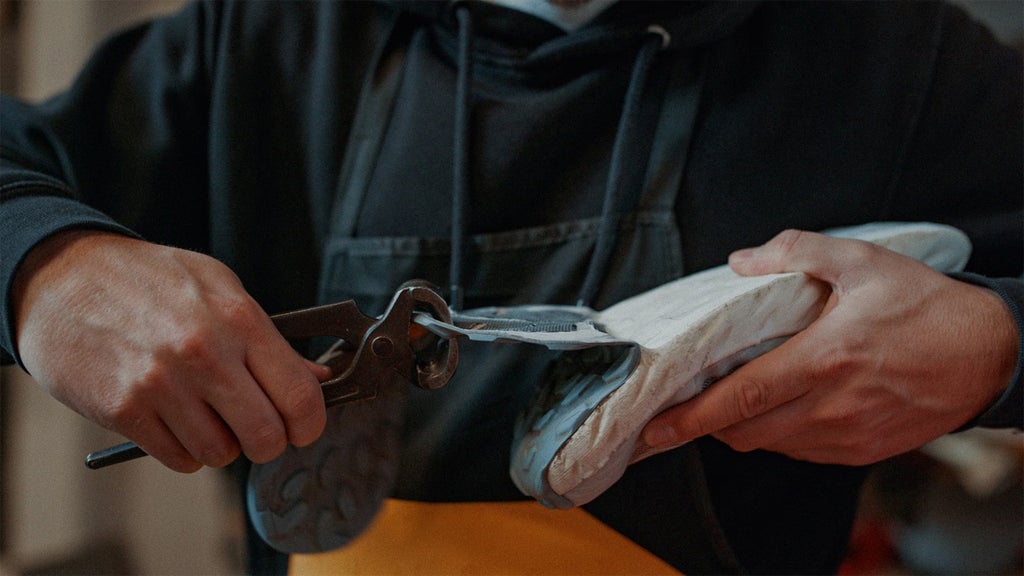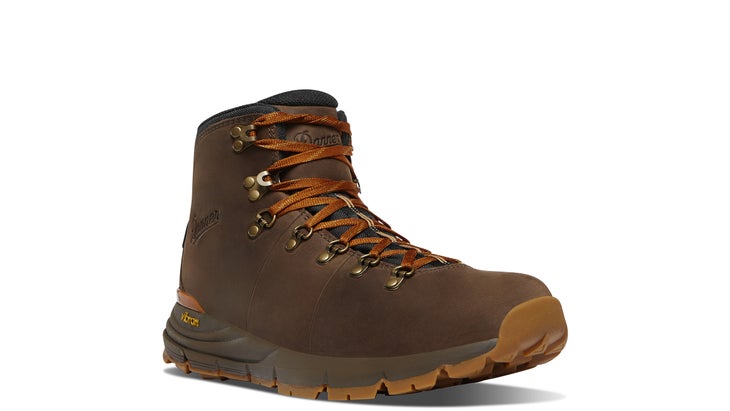



Repairable footwear is nothing new. Go back in time a hundred years, and you could find a cobbler on every Main Street capable of breathing new life into a beat-up pair of leather boots.
It’s not as commonplace now, but cobblers still exist, of course. Take, for example, the heavy duty boots favored by loggers and wildland firefighters. Each piece of thick leather that forms the upper boot can be removed and replaced individually. If you do manage the wear down the nearly half-inch thick soles, they can be pulled off and a new sole can be stitched and nailed down in its place. Boots like these are designed to last years of daily field use, and repairs and fresh soles can boost that number even higher. They also cost more than $500, and weigh nearly four pounds per boot.
What about the shoes that modern backpackers actually wear, like cushy trail runners and lightweight boots? There’s no question that new hiking footwear is better in many ways. They’re lighter, more comfortable, provide better cushioning, and require less break-in. But over time, as all these advancements added up, the idea of repairability was largely left behind. Today, when you wear out a pair of hiking shoes, you throw them away and buy something new.
That’s the conventional wisdom, at least. A few brands are experimenting with modern repairable hiking boots, combining new technologies with traditional repairs. Last year, Danner Boots unveiled a new resoleable version of the Mountain 600 boot called the Mountain 600 Leaf, and plans to expand the line in the future. At La Sportiva, resoling has been a practice for decades, but mostly for climbing shoes and mountaineering boots. This year, the brand is releasing two new resoleable hiking boots, the Aequilibrium Hike and Aequilibrium Trek. Add in customers looking for more durable and sustainable options, and a new era of repairable footwear might be upon us.
To start, it’s worth looking at why modern footwear usually isn’t repairable. First, there are the uppers, which have gotten thinner and more fragile over the years. If the upper fails, there’s little that can be done to mend them. Secondly, there’s the construction. Rather than relying on stitching to attach the uppers to the soles, modern shoes are glued together. Glued soles can be removed and replaced, but it’s a labor-intensive process that requires special construction techniques. Finally, there is the issue of the midsole—the cushy foam that’s sandwiched between a shoe’s upper and outsole that makes modern shoes so comfortable, but is quick to flatten and disintegrate. Like outsoles, midsoles are generally glued in place and are considered permanent in most cases.

At the heart of modern resoling efforts are newfound technologies that make replacing glued soles possible. At La Sportiva, the product team is focusing on approach shoes and hiking boots that employ dense midsoles that are designed to be long-lasting, according to Michael Genauer, La Sportiva North America’s director of product and planning. In the case of the redesigned TX2 Evo approach shoe, the midsole stays in place, while the outsole and a thin compressed EVA layer in between are replaced during a resole. “It’s actually easier to detach these two layers of foam rather than separating the foam and rubber outsole,” Genauer says. “It’s a different way that we’re doing the construction now, with the idea that they can be resoled later in life.”
At Danner, the new resoling process (which the company calls “recrafting”) replaces both the midsole and outsole, which allows more leeway in how their resoleable models feel underfoot.
Danner’s first modern resoleable model, the Mountain 600 Leaf, features a compressible EVA midsole with the soft, springy feel of a running shoe. This spring’s new release, the Mountain 600 Evo, subs in a plastic shank and denser Vibram SPE midsole for a more traditional, supportive feel.
For now, these new resoleable models are mostly mid-cut boots. Making a resoleable trail runner is harder to achieve, because the uppers and midsoles usually break down before the outsole does. “I look forward to the day we can resole something like our Trail 2650, which features a mesh/fabric upper,” says Mark Tingley, Danner’s recrafting supervisor. “The toughest obstacle is having a mesh durable enough to withstand both normal wear and tear and the resoling process. Typically, a boot wouldn’t be eligible for recrafting if the upper fabric is compromised.”
Due to these challenges, sustainability initiatives around trail runners mostly revolve around recycling and repurposing used shoes, rather than offering repairs. A few brands are trying to push the envelope, though. One example is Nnormal, the upstart brand repped by Spanish ultrarunner Kilian Jornet. All Nnormal shoes can be sent in to Vibram cobblers for resoling, though current models feature the mesh uppers that can tear and compressible midsoles that can flatten before the outsole wears away. An upcoming model looks to solve the issue of trashed midsoles in a unique way—by making them removable. The Kboix, set to be released this year, features three sets of extra thick insoles that function as midsoles and offer three levels of support and cushion.

“The aim is developing a shoe that not only has a longer life cycle, but also offers the flexibility to adapt to each individual’s specific needs and the varying terrains or conditions they may encounter,” says Nnormal’s CEO, Sito Luis Salas. Between the removable midsoles, an upper that’s reinforced with Kevlar fibers, and a resoleable outsole, the brand hopes to unveil a shoe that lasts far longer than the average trail runner.
For all of these brands, resoleing services are only available from a few providers. Danner completes the recrafting process in-house, while La Sportiva and Nnormal work with a number of authorized providers. Resoling services aren’t free—customers should expect to pay about $100 for a straightforward resole (repairs to traditional boots that involve replacing sections of the upper can cost much more). They also don’t happen overnight. On average, a resole can take anywhere from two to five weeks.
One additional reason that resoling isn’t as prevalent as it could be? Hikers have learned to treat footwear as disposable, and might neglect simple practices that can extend the life of footwear, like regular cleaning, conditioning, and rotating between shoes.
Donald McClellan, a senior product line manager at Danner, says that boot care is paramount if you want to take advantage of resoling options. “In the end, it all comes down to frequency of wear, terrain, conditions and how well someone takes care of their boots. Proper boot care and conditioning really can extend lifespan.” If possible, Genauer suggests rotating through two or three pairs of shoes instead of wearing a single pair every day. “There’s evidence that this allows midsoles to decompress and boosts longevity compared to daily wear,” he says.
Clearly, resoling operations come at a cost for both brands and consumers. Is it worth it? According to La Sportiva’s 2022 sustainability report, the answer from a sustainability perspective is a resounding “yes”—resoling a pair of shoes has just six to ten percent of the environmental impact compared to manufacturing a new pair of shoes. For consumers, resoling does come at a price, but it’s certainly lower one than buying a brand new pair of shoes. The end result is fewer shoes in landfills, and more money in your pocket.

